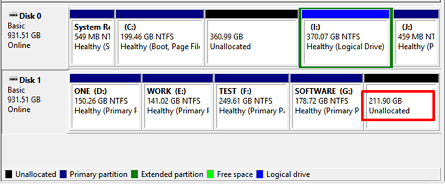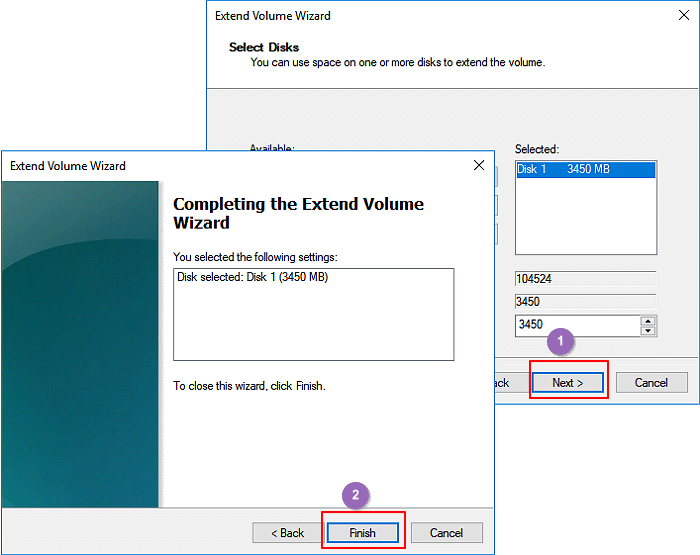How to Add Unallocated Space to D Drive on Windows 10/8/7
What is Unallocated Space?
The computer allocates space on the hard drive as adjacent groups of sectors or clusters. When you create a new file, the operating system finds available space and allocates that space to the file. The unallocated space, also referred to as "free space", is the area on a hard drive where it is not allocated to active files within a file system. In other words, only if the unallocated space is allocated to any drive on your computer it can be used to store data and files.
Generally, the unallocated space is invisible on your computer. You can check the unallocated space in the Disk Management on Windows 10/8/7 computers. In this article, we will introduce how to add unallocated space to D drive. Indeed, if you want to add unallocated space to other drives, this page is also helpful.

How to Add Unallocated Space to D Drive
On Windows 10/8/7 computers, users have three options to use the unallocated space to expand the D drive: professional partition manager, disk management, and DiskPart CMD command. But these three methods require users to have different levels of partition knowledge. Let's check these methods one by one.
- 1. Add Unallocated Space to D Drive with Qiling Partition Manager
- 2. Add Space to A Partition with Disk Management
- 3. Add Unallocated Space to D Drive with DiskPart Command Prompt
1. Qiling Partition Master - Easiest
This method is the easiest one. You don't need to have much partition knowledge. All you need is a professional partition management tool, and this tool will help you with all operations. Here we recommend Qiling Partition Master. It is specialized in computer partition management. Here are the features of Qiling Partition Master.
- Supports users to resize, move, create, format, and delete partitions.
- Supports users to convert from MBR to GPT and vice versa without data loss.
- Enables users to migrate OS to SSD to speed up Windows.
- Recover deleted or lost partitions by scanning the whole disk or unallocated space.
Please download the Qiling Partition Master and follow the guide below to see how to add unallocated space to D drive in 3 steps.
Step 1. Click the partition that next to the unallocated space, select "Resize/Move".

Step 2. Put the mouse on the partition and drag it to the left or right to move the unallocated space.

Step 3. Click "Proceed", and it will execute the operations to add the unallocated space into the target partition eventually.
You can repeat Step 1 and 2 and 3to move the unallocated space to the desired location.
2. Disk Management - Medium
You can also try to add unallocated space to a partition with Disk Management on your computer. This method is best for experienced users, so that it might be a little bit difficult. Don't worry, follow the step-by-step guide below, you can also add the unallocated space to the target drive.
Step 1.Right-click "This PC" and choose "Manage". Then click "Disk Management" to open Disk Management.
Step 2.Right-click the partition you want to manage and select "Extend Volume".

Step 3.Click "Next" to continue adjusting the unallocated space's size to add to the selected partition.
Step 4.Continue to click "Next" and "Finish" to finish the process.

3. DiskPart Command Prompt - Difficult
For professional users, they can manage the unallocated space with DiskPart CMD. Here are the detailed steps.
Step 1.Open DiskPart command prompt:
Type CMDin Search > Right-click Command Prompt > Select "Run as Administrator" > Type diskpartand hit Enter.
Step 2.Type the following command links and hit Enter each time:
- list disk
- select disk 0(replace 0 with your disk number)
- list volume
- select volume d (replace d with the target partition number that you want to extend)
- extend size=number(adjust and add unallocated space to the selected volume in MB)
Step 3.Type exitto close DiskPart.
Now you can check if the unallocated space is added to the D drive.
Bonus Tip: Create New Partition with Unallocated Space
Besides adding free space to an existed partition, you can also create a new partition with the unallocated space. Qiling Partition Master will provide you with a simple and easy method. Keep reading and check how to create a new partition with Qiling Partition Master.
Step 1.Launch Qiling Partition Master. On the main window, right-click on the unallocated space on your hard drive or external storage device and select "Create".
Step 2.Adjust the partition size, file system (Choose the file system based on your need), label, etc. for the new partition.
Step 3.Click on the "Proceed" button to create a new partition.
Watch the following video tutotial and learn how to create a partition in NTFS, FAT, or EXT file system.
The Bottom Line
That's all about how to add unallocated space to D drive. You can choose any of the three methods mentioned above according to your needs. As you can see, Qiling Partition Master always provides you with a quick and convenient experience in partition management. Besides allocating free space, you can also convert the primary partition to a logical partition, merge two partitions into one, and create a WinPE bootable disk with Qiling Partition Master. Now download the software and have a try.
Related Articles
- How to Format 64GB SD Card/USB Flash Drive to FAT32
- How to Make C Drive Bigger Windows 7/10| Assigning More Space to C Drive
- Fixed: We Couldn't Format the Selected Partition | 0x8004242d Error [2022]
- [Easy to Go] How to Change Partition Type ID in Windows 10/8/7 Computer and Laptop